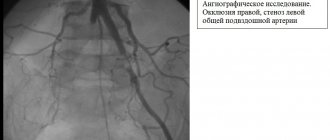Detailed description of the study
Von Willebrand factor (VWF) is a large protein that is a blood clotting factor and is involved in stopping bleeding. It ensures the formation of a clot of platelets at the site of vessel damage and protects factor VIII, an antihemophilic plasma protein, from destruction.
The hemostatic system is a combination of mechanisms that are responsible for stopping bleeding when a vessel is damaged. First, a primary clot is formed due to the action of platelets and the walls of the vessel itself. Next, plasma proteins participate in the formation of a dense blood clot, which finally eliminates the defect. Von Willebrand factor, unlike other clotting factors, is directly involved in the formation of a blood clot.
Von Willebrand factor is synthesized in the bone marrow. In addition, it is produced by cells lining the inner surface of blood vessels (endothelium). The protein is able to bind to factor VIII, and if a vessel is damaged, it delivers it to the site of vessel damage for effective blood clotting. Also, von Willebrand factor binds to a protein on the surface of platelets, which activates their gluing to each other (adhesion). Another of its functions is the attachment of platelets to collagen, which is released when the integrity of the vascular wall is violated. All of these processes ultimately lead to successful stopping of bleeding and restoration of the integrity of the blood vessel.
A defect in the gene that responds to the production of von Willebrand factor leads to the development of hereditary coagulopathy - von Willebrand disease. There are three types of the disease. The first type is the most common. At the same time, the amount of VWF in the blood is moderately reduced and functions are not impaired. The second type is when the functional activity of VWF is impaired, even with sufficient levels in the blood. The third type is severe, observed quite rarely, the amount of EF is sharply reduced.
Clinically, the disease manifests itself as prolonged bleeding of various locations: from the nose, gums, gastrointestinal tract, uterus. The disease is characterized by the appearance of bruises that do not correspond to the size of the injury. Bleeding is also observed after small cuts that do not stop for a long time; bleeding time increases after operations and dental procedures, such as tooth extraction.
In severe forms of von Willebrand disease (often type 3), symptoms similar to hemophilia may occur due to factor VIII deficiency. Muscle hematomas and hemarthrosis appear - hemorrhages into the joint cavity. The consequences of the disease are cerebral hemorrhages, bleeding from internal organs, decreased hemoglobin in the blood (anemia).
Determining the amount of von Willebrand factor in the blood is necessary to assess the state of the coagulation system and timely diagnosis of von Willebrand disease, which leads to bleeding.
Affected Populations
Von Willebrand disease (VWD) is a common inherited bleeding disorder. It affects men and women in equal numbers, although it is more often diagnosed in women because symptoms (such as heavy menstrual bleeding and bleeding after childbirth) are more common in women. BV can be diagnosed at any age and in people of any race or ethnicity.
The disease is estimated to affect 1% of the population. However, the prevalence of symptomatic BV is estimated to be 23–110 per 1,000,000 in the general population. The prevalence of BV varies in the medical literature because different criteria are used to identify individuals with the disorder. For example, as stated above, some medical sources equate low levels of VWF with the presence of VWD, while other sources consider it a risk factor for developing the disorder. In addition, some cases of von Willebrand disease remain undiagnosed or are misdiagnosed. Consequently, it is difficult to determine the true incidence of BV in the general population. Despite this, all forms of type 2 VWD are rare disorders. VWD type 3 is extremely rare, estimated to affect approximately 1 in 250,000 to 1,000,000 people in the general population.
References
- Zozulya, N.I., Kumskova, M.A., Likhacheva, E.A. and others. Clinical guidelines for the diagnosis and treatment of von Willebrand disease. — Congress of Hematologists of Russia, 2021. — 30 p.
- Chernova E.V. von Willebrand factor. — Bulletin of the North-Western State Medical University named after. I.I. Mechnikova, 2018. - T. 10. - No. 4. - P. 73–80.
- Chubukov, Zh.A. Von Willerbrand factor and endothelial dysfunction under stress. - Problems of health and ecology, 2012. - pp. 40-44.
- Pathophysiology: textbook: in 2 volumes / ed. V.V. Novitsky, E.D. Goldberg, O.I. Urazova. — 4th ed., revised. and additional - GEOTAR-Media, 2009. - T. 2. - 640 p.
Why does von Willebrand disease (VWD) develop?
In most cases, the pathology is caused by a gene defect on chromosome 12. Types 1 and 2 of von Willebrand disease (60-80% of cases) are inherited in an autosomal dominant manner. That is, BV occurs in every generation of the family, in males and females.
The third type of BV is when both parents have a mutant gene. It is transmitted recessively, so it occurs only in 5% of cases, more often in consanguineous marriages.
Von Willebrand syndrome can be acquired. These are cases when a person suffers from autoimmune pathologies, hypothyroidism, oncology or diseases of the lymphatic system.
Classification
Pathology is divided into several types.
- Classic type - stage I. The most common form, it occurs easily and without serious complications. Plasma levels are slightly reduced.
- Stage II – observed in 25-30% of patients. The blood test is normal, but the activity of component VIII is reduced.
- Severe degree - stage III. Severe symptoms appear, tests reveal a lack of necessary elements in the blood. People with this form of the disease are most disabled.
- Pseudogemophilia or platelet type - this is what the discoverer-scientist called this stage. The amount of the element responsible for coagulation is normal, but the connection with altered platelet receptors is impaired.
Symptoms
The symptoms of the disease are extremely diverse: from minor episodic bleeding to massive, debilitating bleeding, leading to severe blood loss.
More often, increased bleeding is observed in childhood, decreasing as they grow older, and subsequently there is an alternation of exacerbations and remissions.
Subcutaneous hematomas that appear spontaneously are a symptom of von Willebrand disease
Signs characteristic of von Willebrand disease:
- bleeding for more than 15 minutes after minor injuries or spontaneously recurrent bleeding 7 days or more after injury;
- severe, prolonged or spontaneously renewing bleeding after minor surgical interventions, tooth extraction;
- subcutaneous hematomas that appear after minor traumatic effects or spontaneously;
- hemorrhagic skin rash;
- spontaneous nosebleeds lasting more than 10 minutes or requiring medical intervention due to the intensity;
- blood in feces in the absence of gastrointestinal pathology that can provoke the development of gastrointestinal bleeding;
- severe anemia;
- intense, prolonged menstruation.
Women with von Willebrand disease experience long, intense menstruation
About 2/3 of patients have mild von Willebrand disease, most of whom have no symptoms. Approximately 30% suffer from severe and moderate forms.
Therapy
In case of a mild form of the disease, treatment is carried out if necessary, for example, due to an emergency operation, for injuries or for preventive purposes.
The most vulnerable category of patients are pregnant women. Therapy consists of the use of drugs and frequent blood transfusions. Only in this way can excess blood loss during childbirth be avoided.
The following drugs are used to treat children:
- cryoprecipitates;
- fresh frozen plasma;
- homeopathic medicines.
Constant use of medications is necessary for people with severe forms of pathology. For this purpose, medications are prescribed that have a hemostatic effect and contain a component necessary for clotting.
For women, additional hormonal treatment is recommended.
Sometimes, in rare cases, surgery is performed to ligate the vessels or remove some part to stop the hemorrhage.
Important! It is impossible to get rid of the disease forever; only symptom relief and prevention are possible.
When the pathology occurs in a severe stage, the patient is sometimes assigned a disability. But more often, people with a plasma element content below 5% do not live to be thirty years old.
Diagnostics
The pinch method is used in diagnosis
The disease is difficult to diagnose. It is not uncommon for pathology to be detected in a patient only in adolescence. First, anamnesis is collected and it is determined whether close relatives had the problem. If there is a hereditary factor and spontaneous bleeding, then this allows a preliminary diagnosis to be made.
To clarify, blood tests are carried out in a laboratory. X-rays of the joints are also taken to determine hemorrhages in them. Both the tourniquet and pinch test are performed. A stool blood test is required. An accurate diagnosis is made only after receiving all the examination results.
Relationship between BV and pathologies in connective tissue
Research conducted by modern scientists has established the relationship between von Willebrand disease, as well as defects and anomalies in the development of connective tissue cells.
This relationship is manifested in the following violations:
- Mitral valve prolapse and pathologies of other heart valves,
- Dislocations in the joints due to disturbances in the ligaments of the muscular organs,
- Hyperelastosis of the skin,
- Degenerative myelopathy,
- Marfan syndrome manifests itself in cardiac pathologies, disorders of the eye organ, as well as elongation of skeletal bones in the body.
How close this relationship is between these two pathologies and its etiology needs to be clarified through research by scientists.
Dependence of the development of the disease on the type of genetic inheritance
Using research, geneticists concluded that the pathogenesis of von Willebrand disease depends on the nature of genetic inheritance.
If the patient received deformed genes from one of his biological parents (intrauterine formation of a heterozygous fetus), then mild symptoms appear, or they are completely absent.
With homozygous genetic inheritance (from two biological parents), then von Willebrand disease occurs in a severe clinical form, with all types and characteristics of bleeding, and quite often with the complete absence of the f VIII antigen in the blood plasma.
Less severe symptoms also appear than in the pathology of hemophilia, in lesions of the articular part of the body and in the muscular organs.
Treatment
The goal of treatment is to increase the concentration or replace missing blood clotting factors. Treatment can be prophylactic or on demand for acute bleeding.
Von Willebrand disease is treated in three ways (depending on the severity of the condition):
- The use of drugs that increase the level of von Willebrand factor.
- Replacement therapy with blood products containing von Willebrand factor.
- Local therapy for damage to the mucous membranes and skin.
Von Willebrand disease is an indication for the use of blood products containing vWF
The main groups of drugs used in treatment:
- hormonal agents;
- antifibrinolytic drugs;
- local hemostatics;
- plasma concentrates.
Prevention
For dynamic treatment, it is necessary to adhere to the rules of prevention:
- active and healthy lifestyle;
- avoid injuries and dangerous sports;
- plan your pregnancy with a gynecologist;
- follow the doctor's instructions and take prescribed medications;
- monitor body weight;
- See your doctor regularly.
Despite the fact that the pathology is not very common, if the symptoms are ignored and there is no treatment, it can result in disability and death. The main thing is to diagnose the disease in time and begin therapy. Therefore, you should not neglect preventive examinations with a doctor.









